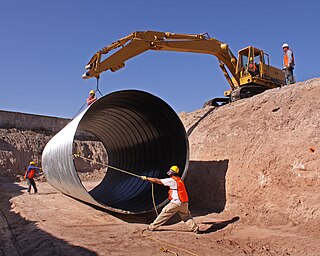The Occupational Safety and Health Administration is a regulatory agency of the United States Department of Labor that originally had federal visitorial powers to inspect and examine workplaces. The United States Congress established the agency under the Occupational Safety and Health Act, which President Richard M. Nixon signed into law on December 29, 1970. OSHA's mission is to "assure safe and healthy working conditions for working men and women by setting and enforcing standards and by providing training, outreach, education, and assistance." The agency is also charged with enforcing a variety of whistleblower statutes and regulations. OSHA's workplace safety inspections have been shown to reduce injury rates and injury costs without adverse effects on employment, sales, credit ratings, or firm survival.

Workers' compensation or workers' comp is a form of insurance providing wage replacement and medical benefits to employees injured in the course of employment in exchange for mandatory relinquishment of the employee's right to sue his or her employer for the tort of negligence. The trade-off between assured, limited coverage and lack of recourse outside the worker compensation system is known as "the compensation bargain.” One of the problems that the compensation bargain solved is the problem of employers becoming insolvent as a result of high damage awards. The system of collective liability was created to prevent that and thus to ensure security of compensation to the workers.

Lock out, tag out or lockout–tagout (LOTO) is a safety procedure used to ensure that dangerous equipment is properly shut off and not able to be started up again prior to the completion of maintenance or repair work. It requires that hazardous energy sources be "isolated and rendered inoperative" before work is started on the equipment in question. The isolated power sources are then locked and a tag is placed on the lock identifying the worker and reason the LOTO is placed on it. The worker then holds the key for the lock, ensuring that only they can remove the lock and start the equipment. This prevents accidental startup of equipment while it is in a hazardous state or while a worker is in direct contact with it.

The Health and Safety at Work etc. Act 1974 is an act of the Parliament of the United Kingdom that as of 2011 defines the fundamental structure and authority for the encouragement, regulation and enforcement of workplace health, safety and welfare within the United Kingdom.

The Control of Substances Hazardous to Health Regulations 2002 is a United Kingdom Statutory Instrument which states general requirements imposed on employers to protect employees and other persons from the hazards of substances used at work by risk assessment, control of exposure, health surveillance and incident planning. There are also duties on employees to take care of their own exposure to hazardous substances and prohibitions on the import of certain substances into the European Economic Area. The regulations reenacted, with amendments, the Control of Substances Hazardous to Work Regulations 1999 and implement several European Union directives.
The history of fire safety legislation in the United Kingdom formally covers the period from the formation of the United Kingdom of Great Britain and Ireland in 1801 but is founded in the history of such legislation in England and Wales, and Scotland before 1708, and that of the Kingdom of Great Britain from 1707 to 1800.
The WorkCover Authority of New South Wales was a New South Wales Government agency established in 1989. The agency created regulations to promote productive, healthy and safe workplaces for workers and employers in New South Wales. The agency formed part of the Safety, Return to Work and Support Division established pursuant to the Safety, Return to Work and Support Board Act, 2012 (NSW).
A safety management system (SMS) is designed to manage safety risk in the workplace, occupational safety being defined as the reduction of risk to a level that is as low as is reasonably practicable (ALARP) to prevent people getting hurt.

WorkSafe Victoria is the trading name of the Victorian WorkCover Authority, a statutory authority of the state government of Victoria, Australia.
A lone worker (LW) is an employee who performs an activity that is carried out in isolation from other workers without close or direct supervision. Such staff may be exposed to risk because there is no-one to assist them and so a risk assessment may be required. Lone workers are now often supported by cloud-based automated monitoring systems and specialised monitoring call centres - often referred to as an 'Alarm Receiving Centre' or 'ARC' in the UK, or 'Emergency Dispatch Center' or 'EDC' in the US.

The Control of Noise at Work Regulations 2005 place a duty on employers within Great Britain to reduce the risk to their employees health by controlling the noise they are exposed to whilst at work. The regulations were established under the Health and Safety at Work etc. Act 1974 and implement European Council directive 2003/10/EC. The regulations replaced the 'Noise at work regulations 1989' which previously covered noise in the workplace. The regulations came into force for most industries on 6 April 2006 with the music and entertainment sectors coming into line two years later on 21 April 2008. In Northern Ireland the legislation is dealt with in 'The Control of Noise at Work Regulations 2006.

The Lifting Operations and Lifting Equipment Regulations 1998 (LOLER) are set of regulations created under the Health and Safety at Work etc. Act 1974 which came into force in Great Britain on 5 December 1998 and replaced a number of other pieces of legislation which previously covered the use of lifting equipment. The purpose of the regulations was to reduce the risk of injury from lifting equipment used at work. Areas covered in the regulations include the requirement for lifting equipment to be strong and stable enough for safe use and to be marked to indicate safe working loads; ensuring that any equipment is positioned and installed so as to minimise risks; that the equipment is used safely ensuring that work is planned, organised and performed by a competent person; that equipment is subject to ongoing thorough examination and where appropriate, inspection by competent people.

The Occupational Health and Safety Act 2000 is a repealed statute of New South Wales (NSW). The Act was repealed by the Work Health and Safety Act 2011.

Occupational safety and health (OSH) or occupational health and safety (OHS), also known simply as occupational health or occupational safety, is a multidisciplinary field concerned with the safety, health, and welfare of people at work. These terms also refer to the goals of this field, so their use in the sense of this article was originally an abbreviation of occupational safety and health program/department etc. OSH is related to the fields of occupational medicine and occupational hygiene.
South African labour law regulates the relationship between employers, employees and trade unions in the Republic of South Africa.
The Occupational Health and Safety (OHS) Regulation of British Columbia is the primary source of law governing workplace health and safety, which was most recently amended in 2016. It sets the standard to which workplaces must attain when inspected by WorkSafeBC, unless they are exempt from inspection, e.g. mines.

The Provision and Use of Work Equipment Regulations 1988, commonly abbreviated to PUWER 1998 or simply PUWER, is a statutory instrument of the United Kingdom. It regulates the standards of safety for equipment used in work environments. Its obligations apply to both employers and employees, as well as those who provide equipment for others to use at work.
MS 1722:2011 – Occupational Safety and Health Management Systems – Requirements is a Malaysian Standard that provides requirements on Occupational Safety and Health Management Systems (OSHMS) and basis for the development OSH systems in an organisation. The MS 1722 standard enable an organization to manage its OHS risks and improve its OHS performance. The requirements of the standard are intended to address OHS for employees, temporary employees, contractors and other personnel on site rather than the safety of products and services. The standards provide a more effective method of protecting employees and others from workplace injuries and illnesses and demonstrate management commitment in meeting OHS requirements.

Common Sense, Common Safety was an October 2010 report by David Young, Baron Young of Graffham. It was commissioned by the British government to address a perceived compensation culture. The report made a number of recommendations to reduce bureaucracy over risk assessment requirements and to improve accountability of decisions made on health and safety grounds by local authorities. Young also recommended reform in the legal processes for personal injury claims and for limits to be placed on claims management companies.
The operations manual is the documentation by which an organisation provides guidance for members and employees to perform their functions correctly and reasonably efficiently. It documents the approved standard procedures for performing operations safely to produce goods and provide services. Compliance with the operations manual will generally be considered as activity approved by the persons legally responsible for the organisation.







